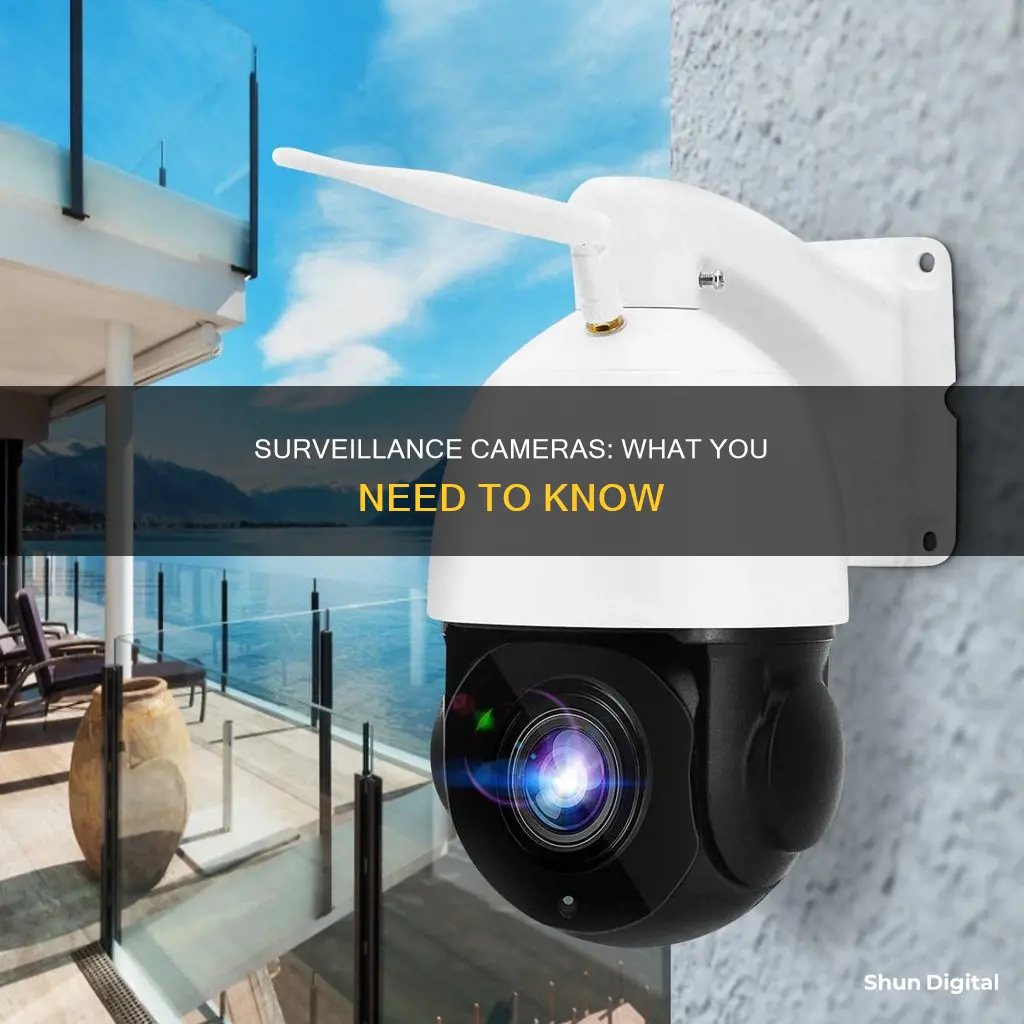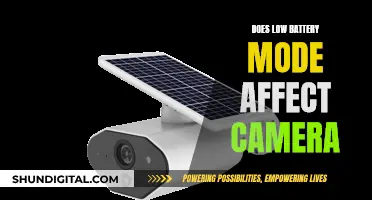
Surveillance cameras are an increasingly popular way to monitor homes, public spaces, and populations. There are two main types of security cameras: consumer-grade and commercial-grade. Consumer-grade cameras are usually sold in bundles of 8 or 16, come with a video recorder, and sell for less than $1000. Commercial-grade cameras, on the other hand, start at about $400 per camera and offer higher performance and better low-light video capture. When choosing a security camera, it's important to consider factors such as indoor vs. outdoor usage, wired vs. wireless, video resolution, field of view, night vision, storage type, and additional features like facial recognition and privacy shutters. While surveillance cameras can enhance safety and security, there are also concerns about privacy and the potential for misuse or abuse.
| Characteristics | Values |
|---|---|
| Usage | Indoor, outdoor, or both |
| Wired or wireless | Wired, wireless, or wire-free |
| Resolution | 1080p or higher |
| Field of view | 130-160 degrees |
| Night vision | Yes, no, or colour |
| Storage | Cloud, local, or both |
| Multi-factor authentication | Yes, no |
| Privacy zones | Yes, no |
| Facial recognition | Yes, no |
| Camera privacy shutter | Yes, no |
What You'll Learn

Indoor vs. outdoor cameras
When it comes to surveillance cameras, one of the most important considerations is whether you need an indoor or outdoor camera. This choice will depend on various factors, including the location, weather conditions, lighting, and the level of durability and intrusion required.
Indoor Cameras
Indoor cameras are designed to be used inside homes or buildings, where they are protected from external elements. They are usually smaller, more lightweight, and less intrusive than outdoor cameras. Indoor cameras don't need to be as durable or weatherproof as outdoor cameras, as they are typically placed in climate-controlled environments. However, they still need to be able to capture clear images in low-light conditions and handle sudden changes in lighting.
Outdoor Cameras
Outdoor cameras, on the other hand, are built to withstand various weather conditions, such as rain, snow, extreme temperatures, and wind. They are generally made of more durable materials, such as metal, and may be heavier or housed in a casing to prevent tampering. Outdoor cameras also need to handle dynamic lighting situations and be able to adapt to complex lighting environments, such as the transition from a dark interior to a bright exterior.
Dual-Purpose Cameras
It's worth noting that some cameras are designed for both indoor and outdoor use, offering dual-purpose functionality. These cameras, such as dome cameras and PTZ cameras, can be a good choice if you need flexibility in your surveillance setup.
When choosing between indoor and outdoor cameras, consider the specific requirements of your surveillance system, the location where the cameras will be placed, and the level of durability and weather resistance needed. Additionally, factors such as lighting conditions, intrusion protection, and image quality should also be taken into account when making your decision.
Batch Processing Power: Copying Adjustments in Camera Raw
You may want to see also

Wired vs. wireless cameras
Deciding between wired and wireless security cameras depends on your needs and expectations of the system.
Wired Cameras
Wired security cameras are ultra-reliable and provide a constant power source. They are a good choice for homeowners who don't need to move the cameras around a lot and want to monitor multiple parts of their property. They are a bit tricky to install and often require drilling and routing cords to a power source and internet network. However, they have fewer connectivity issues and are harder to steal since they are physically connected to the house. They are also less susceptible to hacking and other potential breaches.
Wireless Cameras
Wireless cameras are easier to install and are a better option for renters or those who want a simpler setup. They can be wire-free, meaning they have no wires at all and run off batteries or solar power. Wireless cameras are more flexible and can be rearranged or moved to a new location. However, they may have connectivity issues if the Wi-Fi drops or another signal interferes. Wireless cameras are also susceptible to power outages and may require recharging or replacing batteries.
How to Fight Camera-Based Speeding Tickets in Tennessee
You may want to see also

Cloud storage vs. local storage
When it comes to surveillance cameras, there are two main types of storage to choose from: local storage and cloud storage. Each has its own advantages and disadvantages, and the best option for you will depend on your specific needs and preferences.
Local Storage
Local storage, also known as on-premises storage, involves saving your video clips and footage directly onto a physical device, such as a memory card, hard drive, or network video recorder (NVR) located within your property. Local storage offers several benefits, including enhanced security and privacy, as no one can access the recordings without the memory card, and better video quality, as there is no compression process involved. It is also generally more affordable in the long run, as there are no monthly fees associated with local storage.
However, local storage does have some drawbacks. It is vulnerable to theft, as the storage is inside the recorder, and has limited storage capacity. Additionally, local storage may not be suitable for areas with inconsistent internet service, as it requires a stable connection to function properly.
Cloud Storage
Cloud storage, on the other hand, involves storing your video footage on remote servers accessed through the internet. This type of storage is becoming increasingly popular due to its scalability and adaptability. Cloud storage offers several advantages, including enhanced security, as reputable cloud providers invest heavily in security measures, and easy remote access, as users can access their footage from anywhere with an internet connection.
However, cloud storage also has some drawbacks. It typically involves ongoing subscription fees, which can accumulate over time, and is dependent on a stable internet connection to function properly. Additionally, there may be concerns about data privacy and potential breaches, as your data is stored on servers managed by a third-party provider.
Both local and cloud storage have their own unique benefits and drawbacks. Local storage is ideal for those who prioritise security, privacy, and affordability, while cloud storage is better suited for those who require remote access, enhanced security measures, and the flexibility to scale their storage needs. Ultimately, the decision between local and cloud storage depends on your specific needs, preferences, and budget.
Understanding AE Mode: Camera's Auto Exposure Explained
You may want to see also

Surveillance cameras and privacy
Surveillance cameras are commonplace in today's society, with about 350 million of them worldwide as of 2016. While they are often used to monitor behaviour and gather information for security purposes, their use also raises important privacy concerns.
Public vs Private Spaces
Surveillance in "public" spaces is usually legal, whereas surveillance in "private" spaces, where a person would reasonably expect privacy, is typically not. Examples of private spaces include restrooms, showers, dressing rooms, locker rooms, employee lounges, and first aid rooms.
Video vs Audio Recording
The laws relating to the recording of audio are usually stricter than those for video. In the US, it's generally legal to install a residential security camera and record video, but citizens also have a reasonable expectation of privacy, which extends to video recording. This means that certain private places, such as bathrooms, are off-limits for recording.
Consent
On a national level in the US, it's legal to record a conversation if you have at least one person's consent. This is called the "one-party consent" law and applies to audio recordings. While this law doesn't cover video surveillance, it's relevant because most security cameras record audio as well as video.
Local and State Regulations
The legality of surveillance cameras can get tricky at the local and state levels, with some states having stricter security camera laws than the federal government. It's important to check the regulations in your specific state or locality before installing a security camera.
Privacy Considerations
- Your camera should not be able to see into a neighbour's private spaces, such as their bedroom or bathroom.
- Avoid installing cameras in private spaces in your own home, especially if you have guests or employees who expect privacy.
- Be cautious when using hidden cameras, as they can raise legal issues and may be considered an invasion of privacy.
- Respect your neighbour's privacy and avoid aiming your camera directly at their house.
- Be mindful of the purpose and placement of your camera to ensure it's not invading anyone's reasonable expectation of privacy.
Protecting Your Privacy
If you're concerned about your privacy being invaded by surveillance cameras, there are a few things you can do:
- Block the camera's view by closing curtains or placing obstacles in the way.
- Discuss the matter with the camera owner if you believe your privacy is being invaded.
- In some cases, you may be able to take legal action if your privacy rights have been violated.
In conclusion, while surveillance cameras can be a valuable tool for security and monitoring, it's important to be mindful of privacy considerations and ensure that their use does not infringe on the reasonable expectations of privacy of individuals.
Modern Warfare Mod: Wireless Camera Placement Strategies
You may want to see also

Surveillance cameras and civil liberties
Surveillance cameras are video cameras used for observing an area and are often connected to a recording device or IP network. They are used by citizens, businesses, and governments for a variety of purposes, including crime prevention, intelligence gathering, and protection of property. While these cameras can be useful tools, their use has also raised concerns about civil liberties and privacy.
One concern is the potential for surveillance cameras to violate people's privacy. In democratic countries, there are often laws in place to restrict governmental and private use of surveillance, but even so, the very presence of cameras can make people feel like they are under constant observation. This can have a chilling effect on free speech and assembly, two of the fundamental rights and freedoms guaranteed to individuals.
The use of surveillance cameras by government agencies is particularly controversial. In the United States, for example, the Department of Homeland Security awards billions of dollars in grants each year for local, state, and federal agencies to install modern video surveillance equipment. This has led to a significant increase in the number of surveillance cameras in cities like Chicago and New York. While these cameras are often justified as necessary for national security and crime prevention, critics argue that they infringe upon personal privacy and freedom.
The collection and storage of data from surveillance cameras are also a concern. Once information is in the hands of the government or other entities, it can be shared widely, retained for years, and accessed without the knowledge or consent of the individuals involved. This data can be used to create detailed profiles of individuals, tracking their movements, communications, and activities. There are also questions about who has access to this data and how it is being used, with reports of innocent individuals facing severe consequences such as being barred from flying or unable to access bank accounts.
Another issue is the lack of transparency and oversight surrounding the use of surveillance cameras. In many cases, the public is not made aware of the extent of surveillance or how the data is being used. This lack of transparency can lead to abuse of power and further erosion of trust in government.
Finally, there is the question of effectiveness. While surveillance cameras may deter some criminal activity, they can also be circumvented or used to target marginalized communities. Additionally, the benefits of these cameras must be weighed against the potential costs, including the financial burden of purchasing and maintaining the equipment and the impact on civil liberties.
Overall, the use of surveillance cameras has become an increasingly complex and controversial issue, with valid arguments on both sides. As technology continues to advance, it is essential to carefully consider the implications for civil liberties and to put in place appropriate regulations and safeguards to protect the rights and freedoms of individuals.
The Evolution of Camera Lenses: Glass and Beyond
You may want to see also
Frequently asked questions
Surveillance cameras can be broadly categorized into two types: consumer-grade cameras and commercial-grade cameras. Consumer-grade cameras are usually bundled with 8 or 16 cameras and a video recorder, selling for less than a thousand dollars. Commercial-grade cameras, on the other hand, offer higher performance and better low-light video capture but are significantly more expensive, with prices starting at around $400 per camera.
When purchasing a surveillance camera, consider factors such as indoor vs. outdoor usage, wired vs. wireless, video resolution, field of view, night vision, storage options (cloud vs. local), multi-factor authentication, privacy zones, facial recognition, and camera privacy shutter.
Surveillance cameras in public places can deter crime, aid in crime prevention, and provide valuable evidence during police investigations. They can also protect against property theft and vandalism. However, some argue that they infringe on civil liberties and privacy, and there are concerns about the potential for misuse or abuse of the data captured by these cameras.







